-
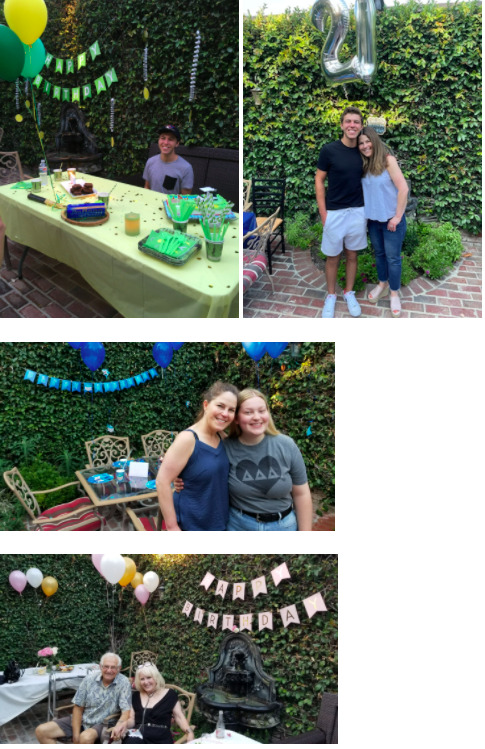
2020
The attached collage of photos displays the COVID-19 birthday parties that have become so well-known in my family over the past year and a half. After a few birthdays were skipped over due to uncertainty at the beginning of the pandemic, my family decided to do birthdays that would be distanced, outdoors, and masked. Unlike the passing of the months, which was meaningless when we were stuck indoors, the changing colors of the “Happy Birthday” sign added a sense of progress and individuality to each celebration. However, these photos, identical aside from the color scheme, are a reminder of the restrictions of the pandemic. While the decorations changed, the masks, socially distant tables, and disposable plates did not. Outdoor family gatherings at my house had once been a choice. However, during this pandemic, we did not have the option to eat indoors on a hot day or go to my uncle’s backyard where social distancing was more challenging.
This collage of photos is relevant not just to illustrate ways in which our lives have changed during the pandemic, but also how we have adapted and maintained our values. These photos reflect what my life has centered around during the pandemic: attempting to engage in my normal activities in a safe manner. This is surely a sentiment that many can relate to. Thus, I feel that, in the future, these photos can demonstrate the adjustments that were made in order to maintain family values and a semblance of normal life.
-

2021-06
This page from my bullet journal displays the workout I conducted each day during the month of June, 2021. The viewer should note three pertinent pieces of information to understand the necessity of this piece for the archive: the bullet journal itself, the exercise habits, and the timeline between the beginning of the pandemic to the actual entry. Primarily, I picked up the hobby of bullet journaling itself during March of 2020. I wanted a method to record my own habits – such as exercise, eating, music taste, and TV shows - in a scrapbook type format during the pandemic. Truthfully, the entire book would contribute to the archive, due to the personal detail and day-to-day routine recorded. Secondly, the workout tracker shows a slight addiction to exercise, with runs or walks every day, in addition to tens of thousands of steps I already took. These overexercising habits began for me during quarantine, with time and stress on my hands, and no healthy ways of coping. Finally, the reader should also acknowledge that I wrote this entry in June of 2021, a full 15 months after the start of lockdown in the US. That timeline shows that lingering effects of the pandemic remain, perhaps even grow with time.
This artifact expresses more about my experience with the pandemic than I can articulate due to one central reason: learning self-love through exercise. Though I’d always struggled with having time on my hands, the pandemic left me feeling more uneasy with loneliness and boredom. Without a healthy way to deal with my emotions, I turned to exercise for the release and endorphins that I needed. Before I knew it, a casual workout each day led to apple watch addiction, calorie counting obsession, and cycles of binge eating and overcompensating through exercise, etc. While this sounds like my own personal journey, quarantine kickstarted and exacerbated these issues for adolescents all over the nation. With the recent introduction of tiktok “What I eat in a day” videos and Chloe Ting’s workout videos, people grew obsessive about wellness and moving their bodies. I learned so much about my body and my brain through this struggle with overexercise and obsession – and I feel grateful for that. Still though, I notice these effects in myself and others. This small contribution of a workout tracker speaks volumes about habits of teenagers after months of loneliness and free time – whether teenagers obtained an obsession with appearance, food, or exercising. And if those issues did not resurrect for some, I’d argue that the pandemic brought many other mental health challenges to surface for my age group. While this submission does little to express my emotions or challenges surrounding my exercise routine, it conveys the lingering effects of mental health tolls and body challenges from the pandemic.
-
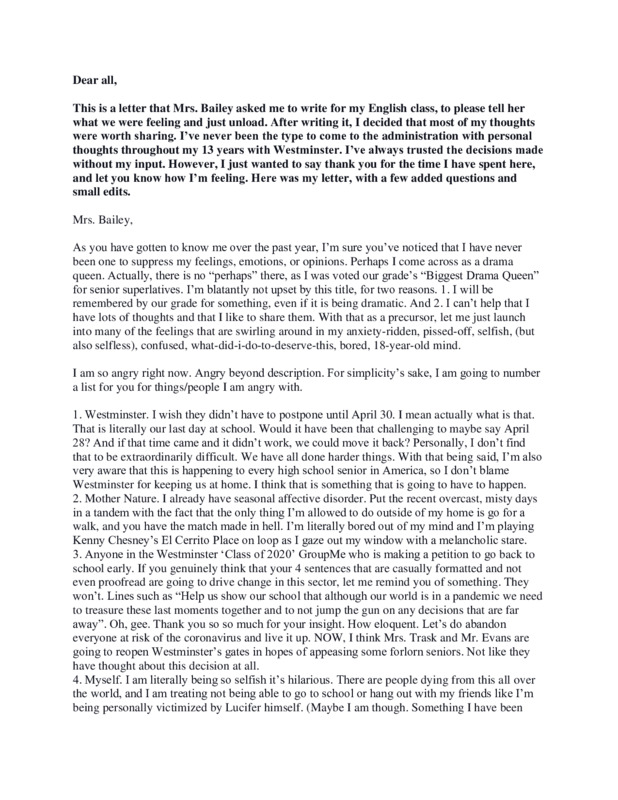
2020-03
I attached a letter I wrote to my senior year English teacher and forwarded to the administration after my high school canceled the rest of my in-person school year in March 2020. When reading it, the reader should specifically acknowledge the timeline and therefore lack of information surrounding the pandemic, as well as the personal memories incorporated. This letter houses pent-up frustration, unfiltered emotion, and a lack of education surrounding the pandemic. As an 18-year-old who just lost the remainder of her senior year, I cater to selfish and emotional tendencies. The reader should recognize that I composed this letter before the CDC, scientists, and government disseminated lots of information and education about the virus, so it embodies the unawareness and confusion that surrounded the pandemic. Aside from that context, the reader should acknowledge the remembrances incorporated into the letter – through imagery and specific quotes, my memories and mourning become more internalized. Clearly, these images and memories can only be understood by members of the high school class or close peers. However, these details such as “alter ego outfit”, “alpha omega day”, and “mudslide” speak to personal experience during the pandemic and allow for my specific outlook.
The letter I wrote bears lots of significance on my experience during the pandemic by allowing me closure and unleashed emotion. As a senior in high school when the pandemic hit, I never received closure with teachers, classmates, sports teams, etc. This letter gave some semblance of finality with my school’s administration and allowed me to express my concerns in an unfiltered fashion. Although reading the letter itself a year and a half later allows me to reflect on my emotions, the experience of actually writing the letter will never leave me either. I sat at my laptop, brainstorming what to write for an English busy-work assignment. I found it difficult to care about school anymore, after I had committed to Vanderbilt, and school moved to zoom. But, quickly, putting my feelings to paper resulted in an outpouring of passion, both positive and negative, and I cried, not sure why. Rereading the letter, as embarrassed as I am about my trivial concerns, I still return to the place of uncertainty, anger, and volatility. Even though I expressed lots of shallow ideas, the letter still bears relevance to me, as I’m proud of my honesty and vulnerability during that time.
-
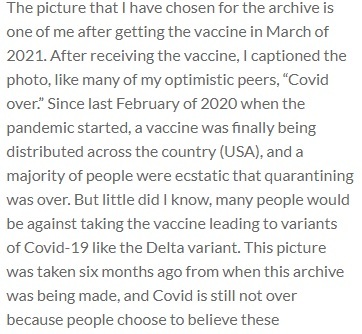
2021-03-30
The picture that I have chosen for the archive is one of me after getting the vaccine in March of 2021. After receiving the vaccine, I captioned the photo, like many of my optimistic peers, “Covid over.” Since last February of 2020 when the pandemic started, a vaccine was finally being distributed across the country (USA), and a majority of people were ecstatic that quarantining was over. But little did I know, many people would be against taking the vaccine leading to variants of Covid-19 like the Delta variant. This picture was taken six months ago from when this archive was being made, and Covid is still not over because people choose to believe these conspiracy theories of the government putting microchips in the vaccine and other ridiculous things like that. Even with a vaccine that is available to everyone in the United States, the pandemic is still raging on with the Delta variant running rampant in the hospitals which has an even worse effect than the normal strain that was going around from February 2020 to around May of 2021. This picture is just to show how hopeful people get from new technology coming out that can save thousands of lives, but ignorant people choose to convince others what they believe since they are spreading their crazy selfish conspiracies. I was so hopeful of having a normal sophomore year of college, but once again Covid is still present (as of September 14, 2021) putting the elderly at risk and quarantining/putting a hold on people’s lives.
-
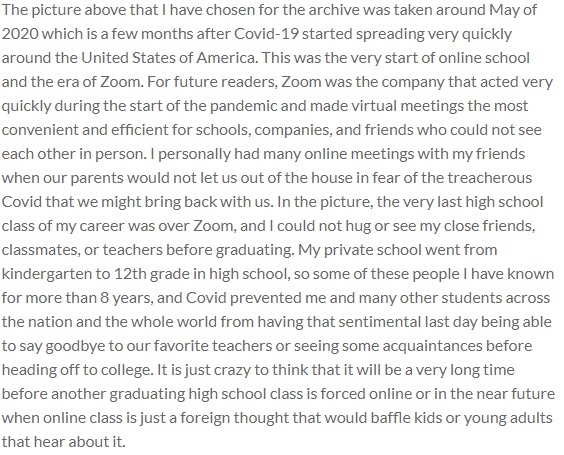
2020-05
The picture above that I have chosen for the archive was taken around May of 2020 which is a few months after Covid-19 started spreading very quickly around the United States of America. This was the very start of online school and the era of Zoom. For future readers, Zoom was the company that acted very quickly during the start of the pandemic and made virtual meetings the most convenient and efficient for schools, companies, and friends who could not see each other in person. I personally had many online meetings with my friends when our parents would not let us out of the house in fear of the treacherous Covid that we might bring back with us. In the picture, the very last high school class of my career was over Zoom, and I could not hug or see my close friends, classmates, or teachers before graduating. My private school went from kindergarten to 12th grade in high school, so some of these people I have known for more than 8 years, and Covid prevented me and many other students across the nation and the whole world from having that sentimental last day being able to say goodbye to our favorite teachers or seeing some acquaintances before heading off to college. It is just crazy to think that it will be a very long time before another graduating high school class is forced online or in the near future when online class is just a foreign thought that would baffle kids or young adults that hear about it.
-
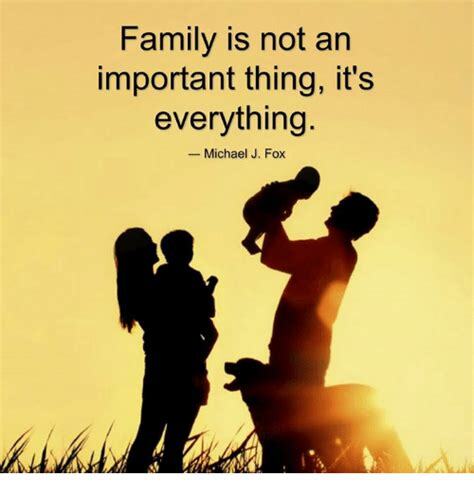
2021-09-16
Starting a new chapter in your life can always be a little stressful simply because of the new change it brings. Coming from a farming county, I had just begun becoming comfortable moving into a big city during my freshman year of college. Second semester rolled around and out of nowhere COVID-19 immediately impacted my life. My once comfortable lifestyle I have adapted to in the big city changed back to my home where I started online classes. This was quite unusual because I had never taken any online classes and found myself struggling to learn from a screen rather than in-person classes. Weeks went by where I struggled to pay attention and succeed in the “classroom”. Although challenging, I adapted to something unfamiliar in my life and found my niche to succeed in a new environment once again.
Adapting to something new can certainly be challenging for people. COVID taught people to adapt to something new in their lives. It brought people together in the community in ways that I had not thought possible. One example of this is when I found out my grandma of 88 years of age became ill with COVID. It was an unfortunate event for my family that took a toll on all of us when we first heard about the news. It became real. Real enough to worry, real enough to take action. Real enough to show the importance of family in times of pain and struggle. Our family had to adapt to my grandmother’s lifestyle for the next couple of months. This meant no big grandma hugs for 5 months until her body recovered from this foreign virus. This took some getting used to as I had not realized the real impact of COVID and perhaps did not see it as dangerous as I thought. Again, I adapted. I adapted to realize that the people around you can make situations like this less painstakingly hard. The comfort and prayers received from family and friends made it comforting to know people cared and were there for me and my family. COVID was something that impacted everyone in different ways. Just remember people listen and people are there.
-
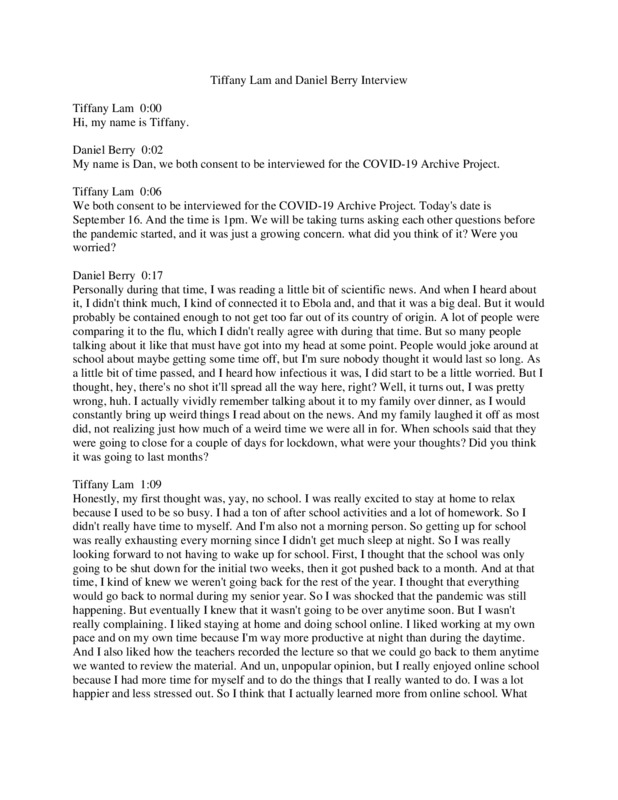
2021-09-16T13:00:00
This is a quick interview between two freshmen in college, recapping our overall thoughts throughout the pandemic.
-
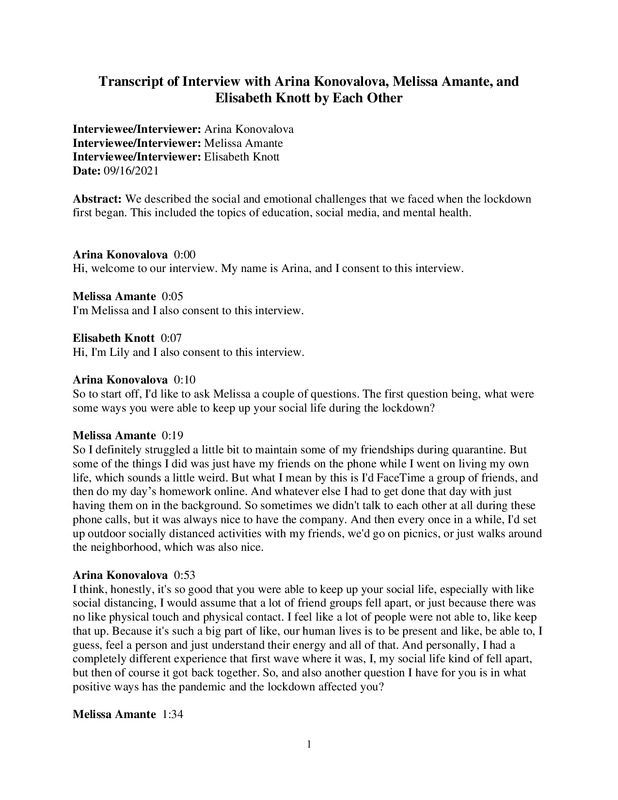
2021-09-16
We described the social and emotional challenges that we faced when the lockdown first began. This included the topics of education, social media, and mental health.
-
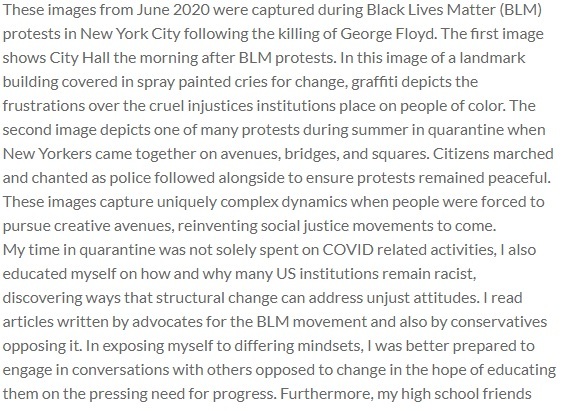
2020-06
These images from June 2020 were captured during Black Lives Matter (BLM) protests in New York City following the killing of George Floyd. The first image shows City Hall the morning after BLM protests. In this image of a landmark building covered in spray painted cries for change, graffiti depicts the frustrations over the cruel injustices institutions place on people of color. The second image depicts one of many protests during summer in quarantine when New Yorkers came together on avenues, bridges, and squares. Citizens marched and chanted as police followed alongside to ensure protests remained peaceful. These images capture uniquely complex dynamics when people were forced to pursue creative avenues, reinventing social justice movements to come.
My time in quarantine was not solely spent on COVID related activities, I also educated myself on how and why many US institutions remain racist, discovering ways that structural change can address unjust attitudes. I read articles written by advocates for the BLM movement and also by conservatives opposing it. In exposing myself to differing mindsets, I was better prepared to engage in conversations with others opposed to change in the hope of educating them on the pressing need for progress. Furthermore, my high school friends and I frequently Zoomed to discuss how our alma mater contributes to racism in both subtle and overt ways. These conversations allowed us to work with fellow alumni, as well as current students, to create a document clearly listing racial inequities within the student body, the faculty, and the curriculum. For each issue that we highlighted, we provided multiple alternatives for how the school could fix the matter in question. While these conversations were unexpected before the BLM protests occurred, they became productive and fulfilling conversations that in and of themselves began to address long held biases, racist representations and undercurrents of injustice within our alma mater’s community and programs.
-
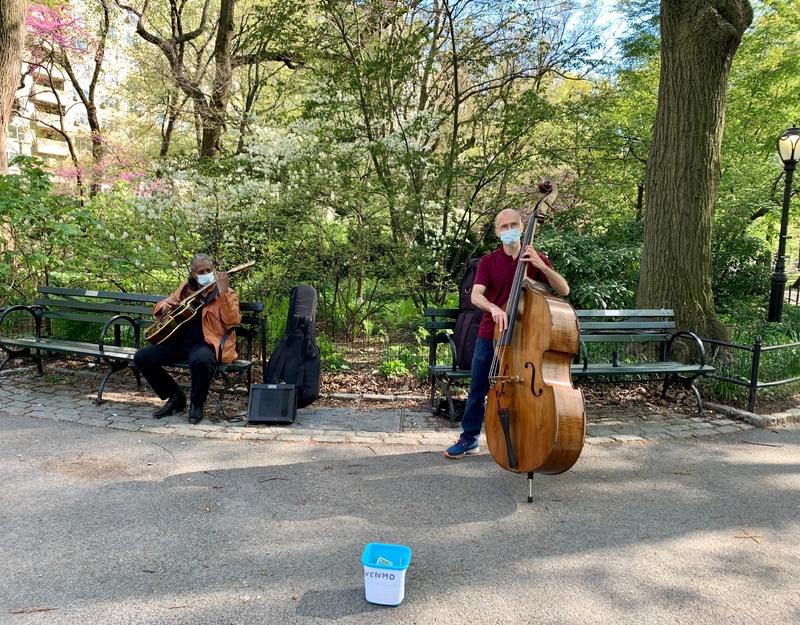
2020-05
These photographs taken from April-June 2020 capture New Yorkers interacting with the empty stress of the city during COVID-19. The first image displays an off duty fireman walking down vacant 5th Avenue, apparently in tribute. His body position highlights the stress, grief, determination, and exhaustion experienced by so many New York frontline workers. The next image was taken of the once bustling streets of SOHO. In this photograph, an older man appears exhilarated during a moment out of quarantine. Getting some fresh air, he turned up his car radio and bellowed out the lyrics of “New York, New York”, the anthem for New Yorkers. The third image captures young cyclists riding, practicing tricks, and laughing. The final snap is of two jazz musicians near the entrance to Central Park, a spot they often inhabited pre-pandemic. They played exactly as they once did, only masked this time.
As a twenty year old who would normally be thrilled to spend the summer at home, surrounded by the lively energy of NYC, I was determined to find a way to interact with my city in a creative and safe way. After completing many projects from home (such as making filter masks for medical staff and collecting supplies for donation), I decided to use my knowledge of and passion for photography to capture fellow New Yorkers doing their part to help lower the spread of COVID and to find moments of camaraderie to fuel their, and others’, fight against this virus. In turn, the act of getting in my car and driving throughout the city, equipped with my Canon Rebel 55mm was my way of finding a measure of peace, purpose, joy, and meaning during the six long months in quarantine in New York City.
-
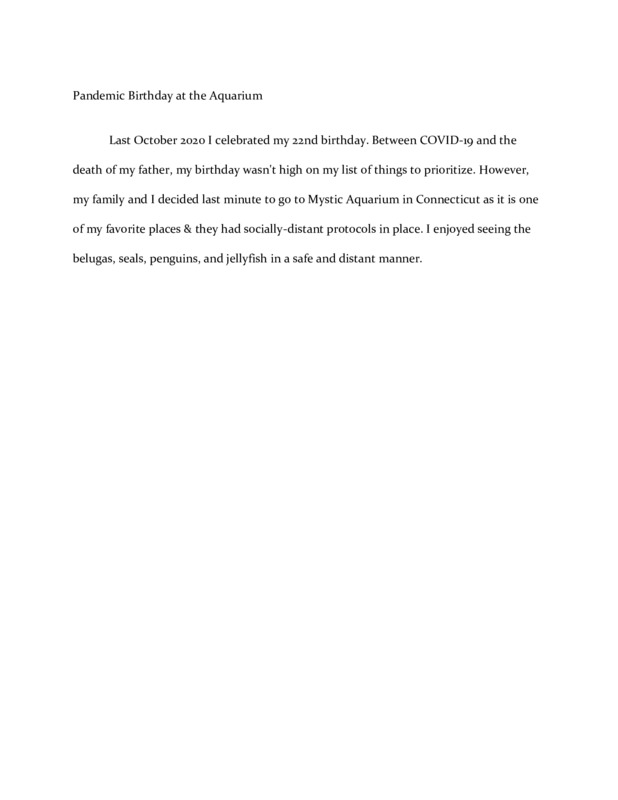
2020-10
Last October 2020 I celebrated my 22nd birthday. Between COVID-19 and the death of my father, my birthday wasn't high on my list of things to prioritize. However, my family and I decided last minute to go to Mystic Aquarium in Connecticut as it is one of my favorite places & they had socially-distant protocols in place. I enjoyed seeing the belugas, seals, penguins, and jellyfish in a safe and distant manner.
-

2020-08-15
The beginning of the pandemic almost perfectly overlayed with my beginning in the coast guard. From my first unit to A school, to my second unit as a rated member, Covid 19 has been a major part of every pit stop. I endure endless safety briefings to the now mandatory Covid 19 vaccine, the military did not fall short in its education and preparation for the pandemic.
-

2021
During the pandemic, I was able to get back into reading and also once the restrictions were lifted, I was able to get back in the gym and start biking again. I would try and bike anywhere from 10-15 miles per day which was a goal of mine to hit.
-

2020-03-01
Since the start of the pandemic, I've begun to both run and hike when I get the chance. After talking with people who have done the same since before the pandemic, they've noted how there is absolutely an increase of people outdoors. For me, it's a great way to escape and improve mental health, and I think it's worth noting how many are trying to find ways to improve themselves and keep going through various ways during such a tough time.
-
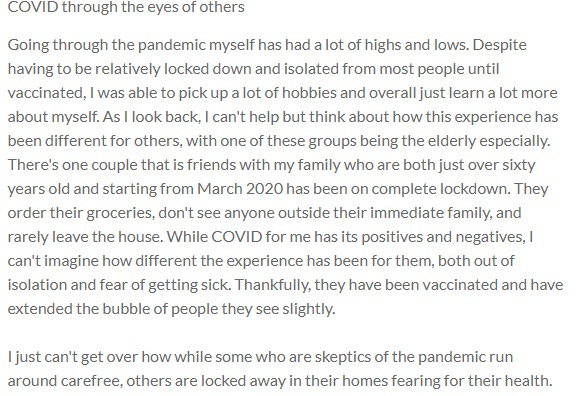
2020-03-01
Going through the pandemic myself has had a lot of highs and lows. Despite having to be relatively locked down and isolated from most people until vaccinated, I was able to pick up a lot of hobbies and overall just learn a lot more about myself. As I look back, I can't help but think about how this experience has been different for others, with one of these groups being the elderly especially. There's one couple that is friends with my family who are both just over sixty years old and starting from March 2020 has been on complete lockdown. They order their groceries, don't see anyone outside their immediate family, and rarely leave the house. While COVID for me has its positives and negatives, I can't imagine how different the experience has been for them, both out of isolation and fear of getting sick. Thankfully, they have been vaccinated and have extended the bubble of people they see slightly.
I just can't get over how while some who are skeptics of the pandemic run around carefree, others are locked away in their homes fearing for their health.
-
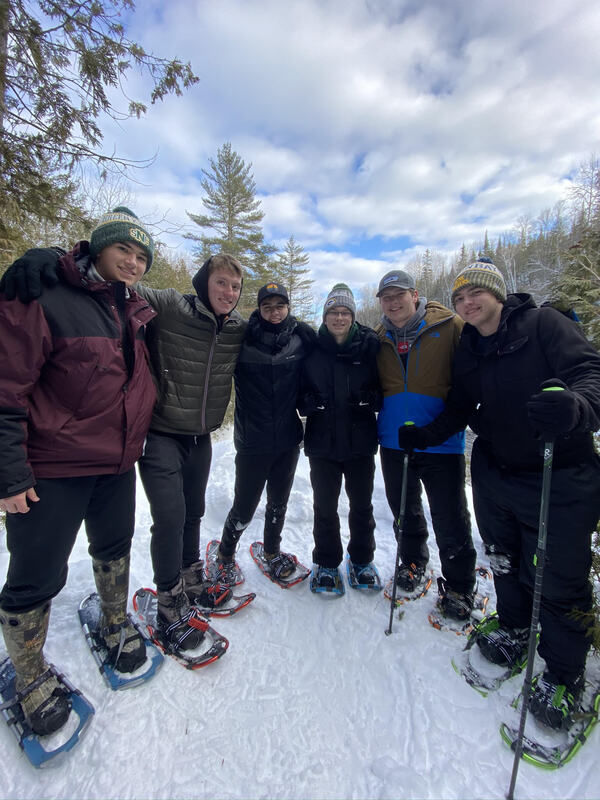
2020-03-15
When we first got the news about school closing down for a couple days, school was the last thing on my friend group and I's minds. When we got off school that gloomy March day, I instantly met up with my friends to go up north for a trip we had been planning for weeks. I was so excited because we had so many activities planned such as snowshoeing, hiking, and snowmobiling. After we all met up, we packed up the car and left. At the time, we had heard things about Covid-19 from around the world, but we were all still pretty foggy on what it is and what it does to you. It was almost as if we acknowledged that it existed, but told ourselves that it could never happen in the United States.
When we got there, we unpacked all of our things and quickly headed outside to go snowshoeing on a nearby path. When we were through with our activities for the day, we headed back to the cabin. I remember checking my phone and having a bunch of texts from my parents and friends saying that they had just cancelled school for another couple of weeks, and I started to think that maybe this whole thing was more serious than I had thought. Looking back on this picture, I look at all of our faces and notice that we were so oblivious to what we were about to experience. This is essentially the picture taken before our lives changed forever.
-
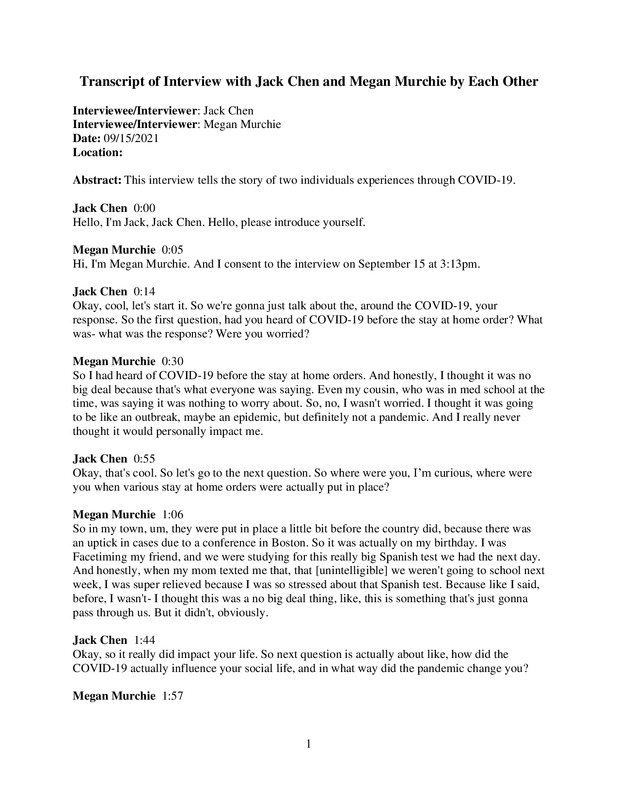
2021-09-15
This podcast tells the story of two individuals experiences through COVID-19.
-
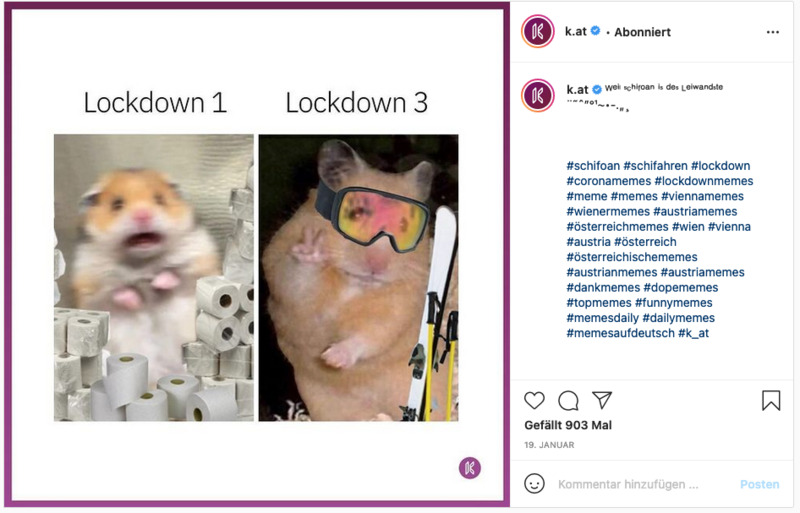
2021-01-19
I saw this meme in January 2021. It was created by an Austrian online news platform called "k.at" and was posted on their Instagram channel. The first picture on the left shows a hamster who is hoarding (or rather "hamstering") toilet paper. This showcases a phenomenon which occurred in Austria as well as in Germany: some people bought as much toilet paper as they could in the beginning of the pandemic out of fear of a lockdown (also other things as e.g. noodles, rice etc.). The result was that most people couldn't buy any toilet paper because it was sold out at most places and the manufacturers of toilet paper couldn't keep up with the production. It was kind of absurd.
The second picture on the right also shows a hamster who seems to have a great time skiing. This should represent the third Austrian lockdown. At this time (around January 2021) many Austrian tourists went skiing even though the numbers of Corona cases were rising. It was quite a controversy at the time because a lot of other activities (like social gatherings) were regulated by the state for health precautions, but the skiing resorts weren't affected (and the Corona cases were also rising in these places).
A little sidenote: The Coronavirus allegedly came to Germany in 2020 because of German tourists who came back from said Austrian ski travels...
-
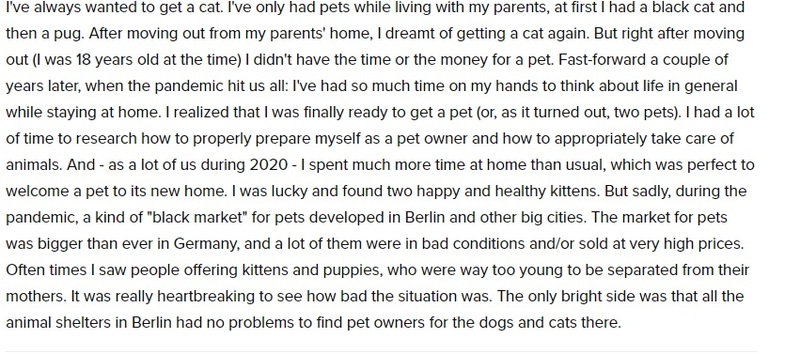
2021-02-01
I've always wanted to get a cat. I've only had pets while living with my parents, at first I had a black cat and then a pug. After moving out from my parents' home, I dreamt of getting a cat again. But right after moving out (I was 18 years old at the time) I didn't have the time or the money for a pet. Fast-forward a couple of years later, when the pandemic hit us all: I've had so much time on my hands to think about life in general while staying at home. I realized that I was finally ready to get a pet (or, as it turned out, two pets). I had a lot of time to research how to properly prepare myself as a pet owner and how to appropriately take care of animals. And - as a lot of us during 2020 - I spent much more time at home than usual, which was perfect to welcome a pet to its new home. I was lucky and found two happy and healthy kittens. But sadly, during the pandemic, a kind of "black market" for pets developed in Berlin and other big cities. The market for pets was bigger than ever in Germany, and a lot of them were in bad conditions and/or sold at very high prices. Often times I saw people offering kittens and puppies, who were way too young to be separated from their mothers. It was really heartbreaking to see how bad the situation was. The only bright side was that all the animal shelters in Berlin had no problems to find pet owners for the dogs and cats there.
-
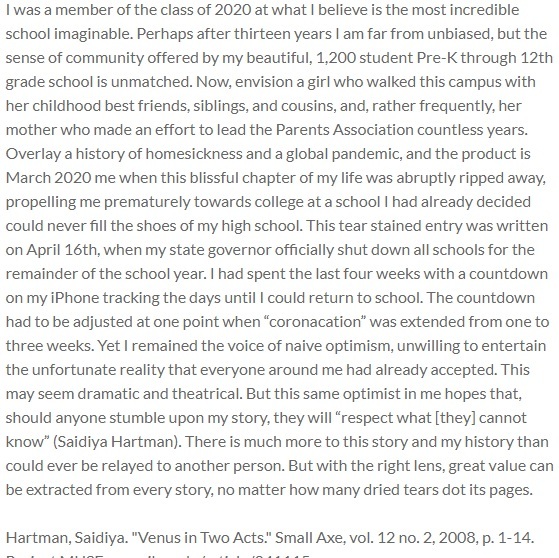
2020-04-16
I was a member of the class of 2020 at what I believe is the most incredible school imaginable. Perhaps after thirteen years I am far from unbiased, but the sense of community offered by my beautiful, 1,200 student Pre-K through 12th grade school is unmatched. Now, envision a girl who walked this campus with her childhood best friends, siblings, and cousins, and, rather frequently, her mother who made an effort to lead the Parents Association countless years. Overlay a history of homesickness and a global pandemic, and the product is March 2020 me when this blissful chapter of my life was abruptly ripped away, propelling me prematurely towards college at a school I had already decided could never fill the shoes of my high school. This tear stained entry was written on April 16th, when my state governor officially shut down all schools for the remainder of the school year. I had spent the last four weeks with a countdown on my iPhone tracking the days until I could return to school. The countdown had to be adjusted at one point when “coronacation” was extended from one to three weeks. Yet I remained the voice of naive optimism, unwilling to entertain the unfortunate reality that everyone around me had already accepted. This may seem dramatic and theatrical. But this same optimist in me hopes that, should anyone stumble upon my story, they will “respect what [they] cannot know” (Saidiya Hartman). There is much more to this story and my history than could ever be relayed to another person. But with the right lens, great value can be extracted from every story, no matter how many dried tears dot its pages.
Hartman, Saidiya. "Venus in Two Acts." Small Axe, vol. 12 no. 2, 2008, p. 1-14. Project MUSE muse.jhu.edu/article/241115.
-
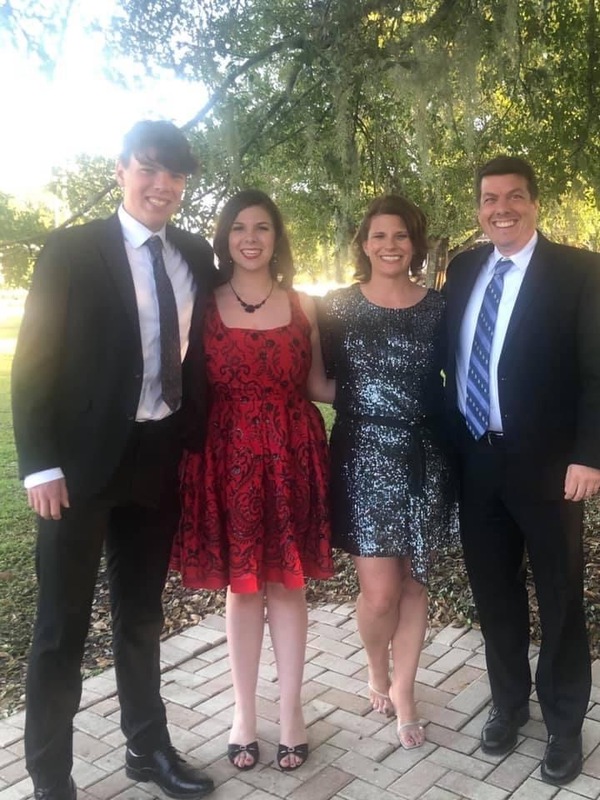
2021-09
When reflecting back on my own experiences from the COVID-19 pandemic, there are a lot of things that come to mind: how my freshmen year of college was completely upended, how I did not feel safe to return to my part-tine job, and especially how nerve-wracking it was to watch world leaders navigate through a crisis we had yet to see in our lifetime. Acknowledging these difficulties that I personally faced, along with the challenges people across the world faced, is crucial because, unfortunately, fear is apart of this story that history will tell; however, I have always found myself someone who tries to remain rather optimistic, which I find myself doing as I share my story. Though I hesitate to call the COVID-19 pandemic a ‘blessing in disguise,’ it did open my eyes and help me to become much more grateful for one huge aspect of my life: my family.
I have been very privileged to have a close and loving family my entire life, though it took me a while to realize what a privilege this was. Sitting down each night to dinner and having a lively conversation with my mom, dad, and younger brother was the norm to me, so I rarely considered the notion that that wasn’t the same for everybody else. When the pandemic first struck and shut down life as we knew it, I – a 19-year-old college student – suddenly found myself back at home living every single day with my family. This was a very jarring shift for me after experiencing the freedom that college granted me, but I quicky began to see how lucky I was to have a loving and accepting family to get through this difficult time with. Of course, this is not to say I never got frustrated with constantly being around my family, but it made me appreciate all the good moments that we had together. Together, we formed a stronger bond as a family that helped us to get through the physical and mental toll the pandemic had brought. From trying new meals together, watching new shows/movies together, to creating wacky videos to share with our friends and family, and so much more, I began to appreciate all the little moments we had together.
As things somewhat begin to return to a state of ‘normalcy,’ I continue to reflect on this time I spent with my family, and I cannot help but feel a huge sense of gratitude. I truly have learned to appreciate everything they have done for me (and continue to do), as well as learned to appreciate many more facets of my life. Nowadays, I find myself much more cognizant of the seemingly simple things and not taking them for granted. It is strange to think that something such as a global pandemic can be the thing that really cements an idea or feeling in our minds, but that is what COVID-19 did for me and my appreciation for my wonderful family.
-
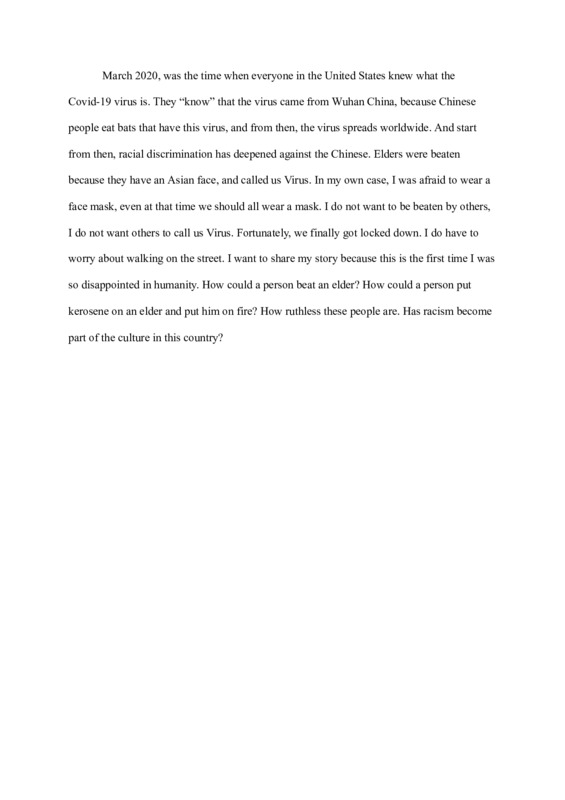
2021-09-15
I will share my story that is about racism because of Covid-19
-
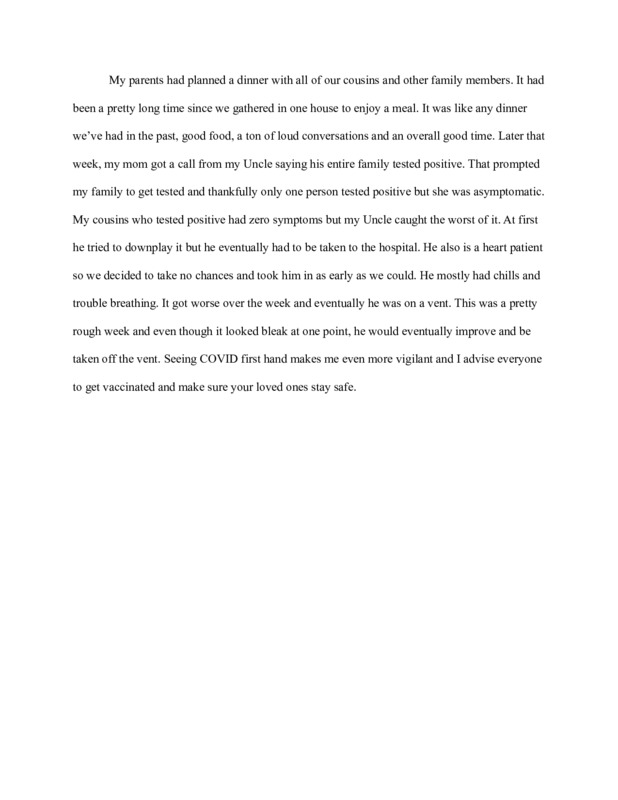
2021-03-12
Text Submission about my personal experience with COVID.
-
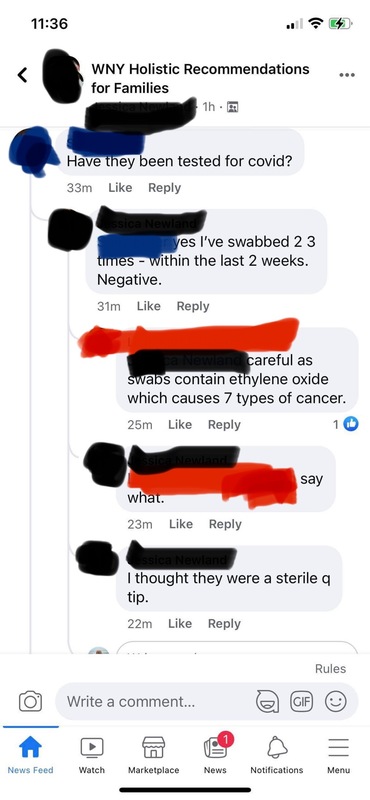
2021-09-14
This is a screenshot from a group several friends are in. The group is holistic-minded which, in itself, is not anti-science but folks who are into holistic medicine seem to be particularly vulnerable to the misinformation and disinformation out there. This screenshot shows one person asking the OP if they’ve tested their child for COVID. The OP answers that they’ve swabbed their child several times. A third person warns the OP that sterile swabs contain ethylene oxide and so they cause cancer. Reuters did some myth-busting regarding this claim. (Link included). It’s so disheartening to see this rampant disinformation and misinformation, especially in communities I formerly felt a part of.
-

2021-09-14
I wrote an opinion piece for Idaho Education News last week after the latest school board meeting in Nampa, Idaho. Since March of 2020 educators have worked tirelessly to ensure that our students continue to receive a quality education. Initially, educators were seen as 'heroes' of the pandemic. However, over the last 9 months, the rhetoric surrounding schools and teachers has turned nasty. Yet, teachers continue to show up every single day and offer learning experiences to all children. At last week's board meeting, the discussion focused primarily on a mask mandate for our district as hospitals in our state began rationing care given the soaring number of Covid-19 cases. There was an even split between the trustees who were in favor of masking and the trustees who were against masking. This split did not come as a shock to me. However, the line of one trustee hit me in my gut, "I guess I go back to the mission statement. I'm here for the kids, so I'm not going to worry about the adults." The mission and vision statement the trustee is referencing states that teachers offer "exceptional learning experiences" for every child. Given the largely unvaccinated population of our community, the high numbers of teachers out sick, and the alarming number of students out sick as mask mandate seemed like a simple request. However, the board did not vote in favor of helping teachers ensure we are able to provide 'exceptional learning experiences.' Are masks the only answer? Not necessarily. Last year, students attended school 4 days per week while the 5th day was reserved for students to connect with students who were in quarantine/sick and unable to attend school. This year, all of those requirements are gone. That being said, students and teachers attend school 5 days per week and there is no time allotted for teachers to connect with students who are quarantined or sick. Given the latest numbers, about 25% of our entire district is out sick. That is 25% of students who do not have access to their teachers.
The article was published on Tuesday, September 14, 2021, and Idaho Ed News shared it on their Facebook page as well. Shortly after 7 pm MST the post has over 160 comments (mostly in favor of teachers), 250 reactions, and over 50 shares. In addition, I have received numerous private messages and emails from other teachers who thank me for giving them a voice during this 'unprecedented' time. While I am still a fairly new teacher with only 3 years of experience, there are veteran teachers who are being pushed to the brink. Many would like to think this is an Idaho problem but the reality is that teachers across the country are feeling unsupported and unappreciated by the communities they serve. I am fearful this will be my last year teaching - I LOVE my job. I remain hopeful that this year turns out to be something amazing.
-
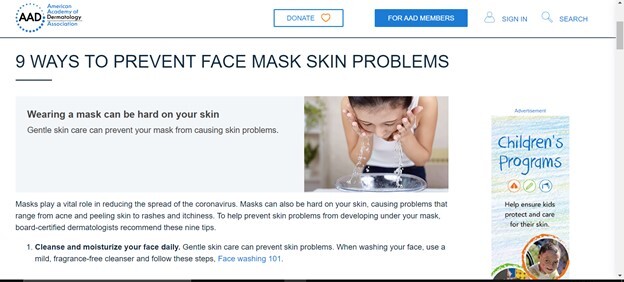
2021
Masks play a vital role in reducing the spread of the coronavirus. Masks can also be hard on your skin, causing problems that range from acne and peeling skin to rashes and itchiness. To help prevent skin problems from developing under your mask, board-certified dermatologists recommend these nine tips.
1. Cleanse and moisturize your face daily. Gentle skin care can prevent skin problems. When washing your face, use a mild, fragrance-free cleanser and follow these steps, Face washing 101.
Dry skin is a common face mask skin problem. Applying moisturizer adds a protective layer that can reduce dryness.
You want to apply moisturizer immediately after washing your face. To get the most benefit from a moisturizer, board-certified dermatologist Carrie L. Kovarik, MD, FAAD, recommends using a moisturizer with one of the following ingredients:
-Ceramides
-Hyaluronic acid
-Dimethicone (which can also create a barrier that helps reduce irritated skin)
You can prevent breakouts from your moisturizer by using a moisturizer formulated for your skin type. When selecting moisturizer, follow this guide:
Oily skin (or when weather is hot, humid): Gel moisturizer
Normal or combination skin: Lotion
Dry to very dry skin: Cream
If you have acne or tend to break out, you can still use a gel moisturizer.
Apply moisturizer before and after wearing a mask.
Moisturizer can prevent problems, especially if you have dry or sensitive skin.
(Tip courtesy of board-certified dermatologist Carrie L. Kovarik, MD, FAAD)
2. Protect your lips by applying petroleum jelly. Dry skin and chapped lips are common face mask skin problems. You can prevent chapped lips by applying petroleum jelly to your lips:
-After washing your face
-Before you put on your mask
-Before bed
To prevent breakouts, take care to apply the petroleum jelly only to your lips.
3. Skip the makeup when wearing a mask. Beneath a mask, makeup is more likely to clog your pores and lead to breakouts. If makeup is necessary, use only products labeled “non-comedogenic” or “won't clog pores.”
4. Avoid trying new skin care products that can irritate your skin. Wearing a mask for even a short time can make your skin more sensitive. To reduce skin problems, avoid trying harsh products, such as a chemical peel, exfoliant, or retinoid, for the first time, says board-certified dermatologist Daniela Kroshinsky, MD, MPH, FAAD.
5. Use less of certain skin care products if your face becomes irritated. When you cover your face with a mask, some skin care products that you’ve used in the past may irritate your skin. If this happens, Dr. Kroshinsky recommends cutting back on products that can irritate your skin, such as:
-Leave-on salicylic acid
-Retinoid you apply to your face
-Aftershave
6. Wear the right mask. To reduce skin problems, look for masks that offer the following:
-A snug, but comfortable fit
-At least two layers of fabric
-Soft, natural, and breathable fabric, such as cotton, on the inside layer that rests against your skin
Wearing a mask that offers a snug, but comfortable fit helps to protect you and others from the coronavirus. You want a snug fit across your nose, on the sides, and under your chin.
A snug, comfortable fit also reduces skin problems. If the mask feels too tight or slides around on your face, it can irritate your skin. You’re also more likely to adjust a poorly fitting mask. When you touch your mask, you can transfer germs to your mask and your face.
The fabric is also important. Avoid synthetic fabrics, such as nylon, polyester, and rayon on the layer that rests against your skin. These are more likely to irritate your skin and cause breakouts.
For more tips on selecting a face mask to prevent the spread of COVID-19, visit the Centers for Disease Control and Prevention at CDC.gov/coronavirus.
7. Take a 15-minute mask break every 4 hours. Health care workers on the frontlines of the coronavirus pandemic have found that this helps save their skin. Of course, only remove your mask when it’s safe to do so and after washing your hands.
Safe places to remove your mask include:
-Outdoors, when you can stay at least six feet away from people
-Inside your car when you’re alone
-At home
8. Wash your cloth masks. Many health care organizations now recommend that you wash a cloth mask after each use. Washing it also removes oils and skin cells that collect inside the mask, which could lead to a skin problem.
You can wash a cloth mask in a washing machine or by hand. Both ways remove germs and other particles. Just be sure to:
-Follow the washing instructions on each mask.
-Wash the masks in hot water unless the instructions say otherwise.
-Use a fragrance-free, hypoallergenic laundry detergent.
After washing your mask, check its shape. If a mask no longer fits snugly (and comfortably), it is less protective.
9. Continue the treatment plan that your dermatologist created for you. If you have a skin condition, such as acne or rosacea, it’s especially important to follow your treatment plan. This can help keep the condition under control.
-
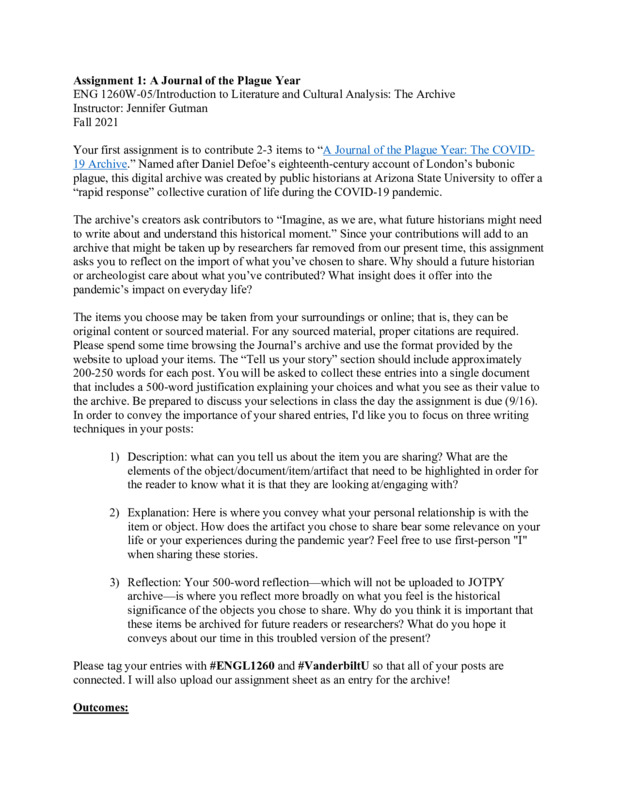
2021-09-16
I'm sharing an assignment sheet for my "Literature and Cultural Analysis" class at Vanderbilt University for the Fall 2021 semester. The class, themed "The Archive," is designed to encourage critical thinking around the concept of the archive and its material practices and embodiments. While we think of the ways in which archives enable research and help to cultivate new knowledge and stories, we also consider how archives encode structures of power and act as sites of forgetting as much as remembering.
I've asked my class of twelve students to contribute to the COVID-19 digital archive as their first writing assignment for the semester. This assignment is designed to introduce them to an existing and regularly updated archive and ask them to think critically about processes of archiving and the decisions that go into selecting, categorizing, and framing the importance of a cultural artifact. My students have been asked to choose 2-3 items from their experience of the pandemic year to share in this public forum. Their contributions will be tagged to sync up with this assignment sheet.
-
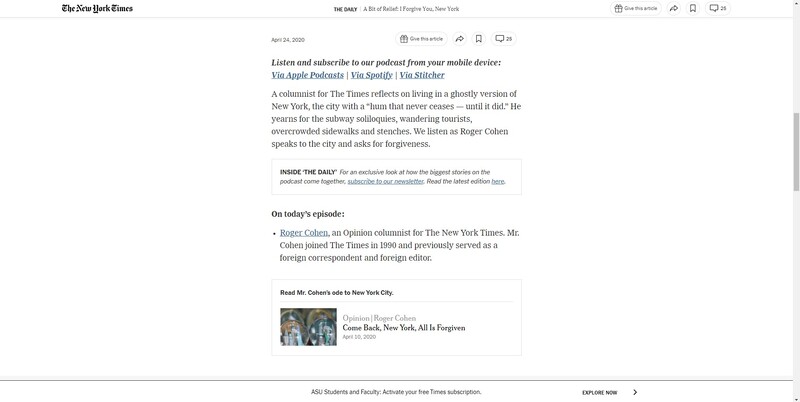
2020-04-24
I remember listening to this episode when it first aired during the peak of the pandemic. I am certain I am not alone in the ways this very raw and heartful lamentation of New York City when the city's fate was uncertain.
-
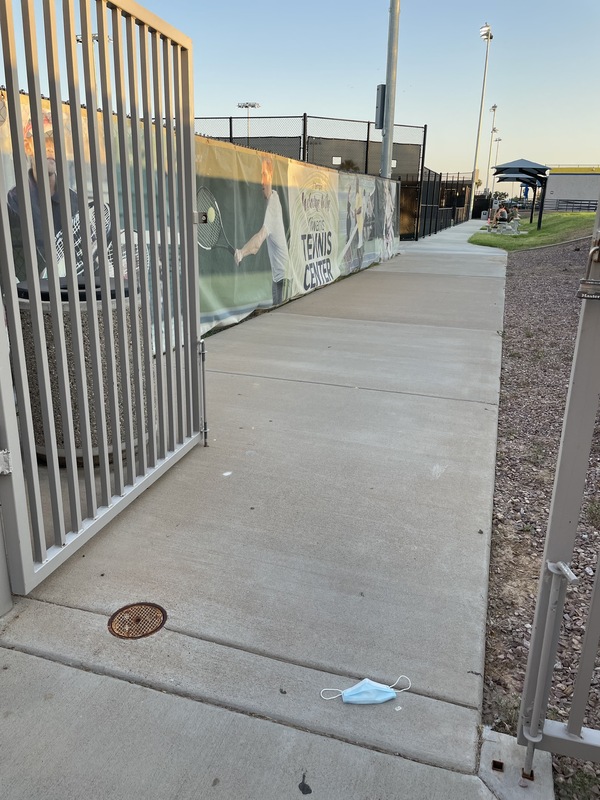
2021-09-13
I took my daughter to play tennis at 5:00 PM. When we left at 6:00, this disposable mask had made its way to the ground, right by the entrance to the tennis courts.
This photograph is part of the mask trash series.
-
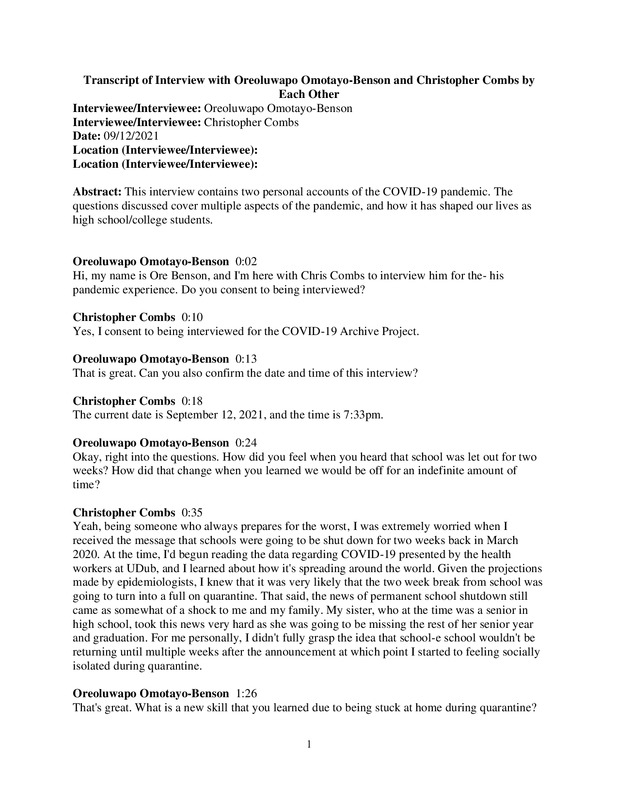
2021-09-12
This interview contains two personal accounts of the COVID-19 pandemic. The questions discussed cover multiple aspects of the pandemic, and how it has shaped our lives as high school/college students.
-
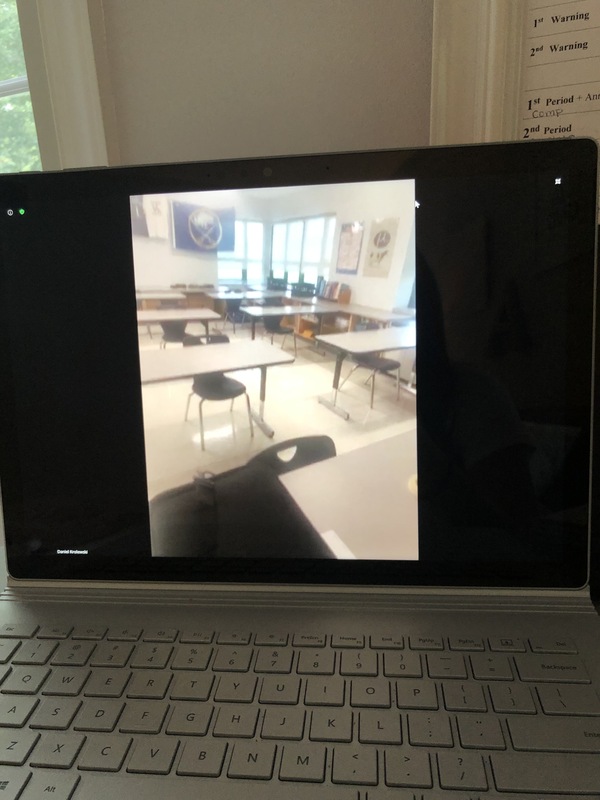
2021-09-09
After being in school for 12 years you get use to the way things. Once covid had hit it was a whole new change and something to get used to. The desk had all been separated from each other, lines in the hallway telling us where to walk to divided us so we weren't so close. Only so many students going on one day to school and the others on the opposite days us. You kind of felt like a freshman in that sense.
-
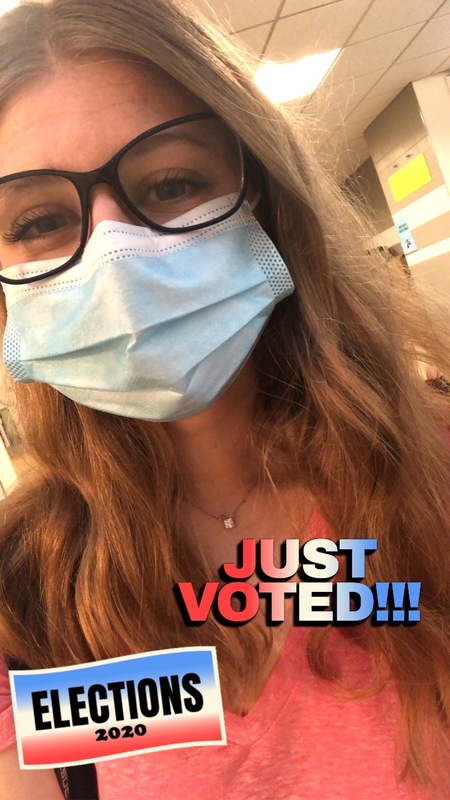
2020-10-08
The picture above is a photo that I took of myself after mailing my absentee ballot for the 2020 election. This was something that was especially exciting amidst the difficulties that Covid-19 had caused in the United States and around the world. Due to the pandemic, most in-person voting was not happening that year. Instead, most people mailed in ballots. As a college student, I needed to register for an absentee ballot in order for me to vote in my home state of New Jersey. I remember that I did this while I was stuck at home over the summer. For me, during the summer of 2020, I did not feel as though I was accomplishing anything. Registering for my absentee ballot was one of the only things that I actually accomplished during this time. In addition, there was much unrest in the country, as well as on social media, that motivated me to register as well. As a 20 year old, this was the first Presidential election that I could vote in, which made it especially important for me. During the summer, with all of the unrest in the country, I was interested to see the areas in which I agreed with my parents, and the areas in which we disagreed. In such a disaster of a year, I wanted to be able to say that I had voted in the election, at the very least. It is my civic duty after all.
I think that this photo is extremely interesting because it is a true time capsule. I am wearing a mask, which characterizes the Covid pandemic. The filter proudly states, “Just Voted!!!” and “Elections 2020”. There is a joy that is evident on my face; there is something exciting about being able to vote in your first presidential election. Throughout my life, I have learned about elections and have always wanted to take part. In the 2016 election, my high-school peers and I, who were nearly competent citizens, were forced to watch from the sidelines. There is also something particularly interesting about an election in an extremely difficult time. It felt important in a way that regular years might not.
-
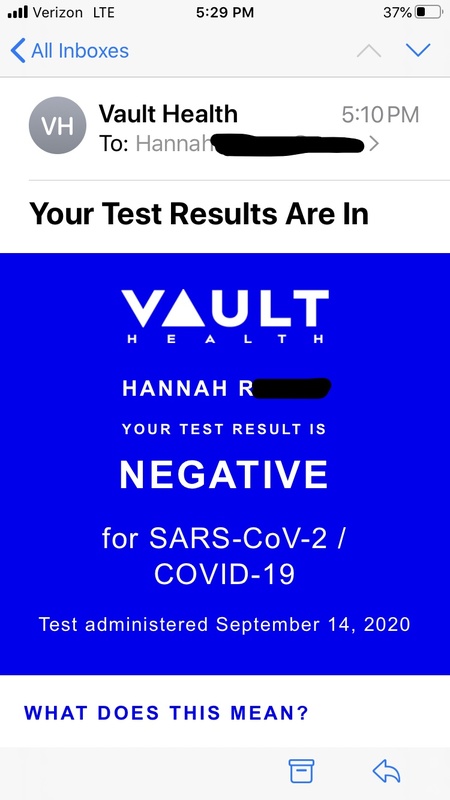
2020-09-16
This photo is a screenshot of an email that I received during the Fall 2020 semester at Vanderbilt University. Throughout the semester, I received many emails that looked exactly like that one. The email is proof of a negative Covid test result, which every Vanderbilt student had to receive each week during the fall semester in order to remain living in their dorm. If a student tested positive, they would be taken from their dorm into quarantine housing. For some context, in March of 2020, all Vanderbilt students were sent home early due to the coronavirus. From March onward through the summer, Vanderbilt students worried about their fate as students. Would we be allowed to return to Nashville in the fall? Would we be subjected to more online “college”, trapped in our childhood bedrooms? This anxiety physically ate away at me, keeping me in a constant state of unease. When we finally heard that we would be coming back to campus, it felt as though an immense, invisible weight had been released from my shoulders. We were told, however, that there would be restrictions to college life. At that moment, I did not care an ounce. I would happily take any variation of college, as long as I would be able to live on campus. One of my major stressors entering that year was that we would be kicked off campus a second time. Callous students loudly proclaimed that this was inevitable, there would be no way that we would last this upcoming year. Comments like this brought the anxiety right back to the pit of my stomach. As a student who was going to be living on campus, what would I do if I was kicked off? Where would I go? I did not even want to think about that as a possibility. But that was the energy that charged the air at Vanderbilt that year: there was a fear and a deep distrust that Vanderbilt would stay open.
One of the key differences between this year and other years at Vanderbilt was the weekly Covid testing (In the spring semester, the Covid testing was twice weekly). Students were required to enroll in times in their schedule when they would trek over to the Rec, or the large gym on campus, to spit in a tube. At the beginning of the year, I would go with my friends during our allotted time. We soon learned, however, that it did not really matter when you went, as long as went sometime during the week. While this was in some ways comical, to walk into the Rec center, with pop music blaring, and spit alongside your college peers, there was something stressful about it as well. It was like constantly turning yourself in; if you did have the misfortune of having Covid, you had willingly given yourself over for the school to come and take you away. Especially at the beginning, fear of Covid was rampant. Even if you felt fine, a scratchy throat may seem like your doom. At the beginning of the semester especially, waiting for the emailed results felt like eternity. And we all knew what would happen to people who tested positive, or those unfortunate enough to be contact traced: they were shipped off in a golf cart for everyone to see, and were banished from the rest of campus. But this was worth it, all of it was worth it for us. The stress of getting tested and the fear of being quarantined was a miniscule price to pay for being able to be on campus, with our friends. It was an escape from our summers of restriction. Or at least, it was for me. And for that, I give Vanderbilt tremendous credit for opening and following through successfully with the covid-testing of all the students each week.
-
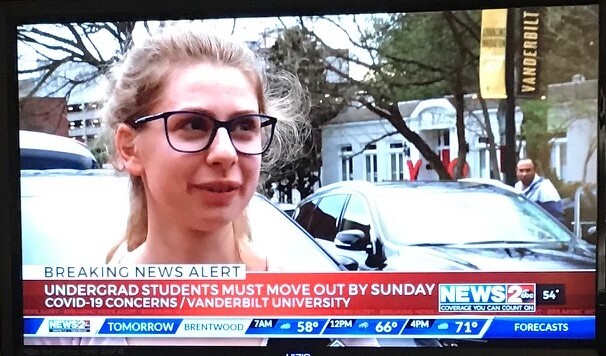
2020-03-11
This is a photo of an ABC news segment that was aired on March 11th, 2020, at the very beginning of the pandemic in the United States. The photo shows an interview of a Vanderbilt student (me!). The caption reads “Undergrad Students Must Move out by Sunday”. The interview was taken on a Wednesday, which had been the day that the students were notified that they would need to vacate the campus. The Monday of that week, March 9th, had been our first day after spring break. That same day, we received the first email about the Coronavirus. It stated that classes would be cancelled for the next two weeks. At that time, some students and parents began to panic. Some students decided to leave campus for those two weeks, and believed that they would simply return after those two weeks. These students only took the belongings that they would need for those two weeks, and many of them left the majority of their things in their rooms. Two days later, on the Wednesday of that week, the students received a second email that we would all need to leave campus, and that we had until that Sunday to move all of things out entirely. Naturally, mass chaos ensued as students struggled to figure out how to move all of their things. Most students did not have any help from parents or family, as many people were afraid to travel. This time was a blur of stress, fear, and sadness as students mourned the year that was left unfinished. It was a charged frenzy of packing and moving, but despite this, all around the Vanderbilt’s campus, friends could be seen hugging and crying, particularly the graduating seniors. It was truly surreal in the worst way possible.
For me, this picture represents that entire, horrific, move-out experience. On the day that I found out that we would need to leave for the remainder of the year, I was in a practice room in my dorm with one of my friends. He had just been telling me how he had been fighting with his father over whether or not to leave during the two weeks without class. He, of course, wanted to stay on campus, but his father was convinced that he needed to come home. I had already conceded to my parents on that battle, and had plane tickets to come home for the Friday of that week. I, like everyone else, thought that I would only be going home for two weeks like the email had explained. I also was willing to be home for the two weeks to see my family, as I had been in the UK over spring break, which had caused major tensions with my parents. Wednesday’s email confirmed our worst fears: we would all be forced to leave for the rest of the year. I remember feeling completely numb. I walked out of the room to call my parents, while my friend called his. As I spoke to my mom, I realized that I would need to pack up all of my things extremely quickly. She advised me to go to the UPS store to get boxes; as soon as my friend and I were both off the phone, we went straight there, buying up many boxes each to begin packing. While we tried to smile and be upbeat, both of us were still in utter shock. With every ounce of my being, I did not want to leave. It was my sophomore year, and college finally seemed to be mine; I had a phenomenal group of friends who I loved deeply, I was involved on campus, and I loved my classes and professors. The tragedy of it all reverberated through me in waves. As devastated as I was, I had a more imminent task to focus on: moving out. Once we had bought our boxes, we realized that we could not carry them back to campus, and ordered an Uber. As I struggled to carry my boxes from the Uber, I noticed a news crew stationed outside of my dorm.
“Could we ask you a few questions?” they called to the pair of us as we labored with our boxes. My insides swirled with anger and frustration about the whole situation, about the unfairness of it all.
“Yeah, for sure!” I responded. Maybe someone would actually listen to us, and understand the insanity that we were experiencing. While I don’t remember the exact questions asked, I remember telling them that we had just picked up boxes as we were required to leave campus later that week. I attempted to communicate how upsetting this was to the entire student body. While I have never actually seen this news clip, a friend of mine sent me this picture of me being interviewed. For me, this picture captures how surreal the move out was. I was on the news, and I forgot all about it. It honestly meant nothing to me in that moment, as my world was pulled out from beneath me.
-
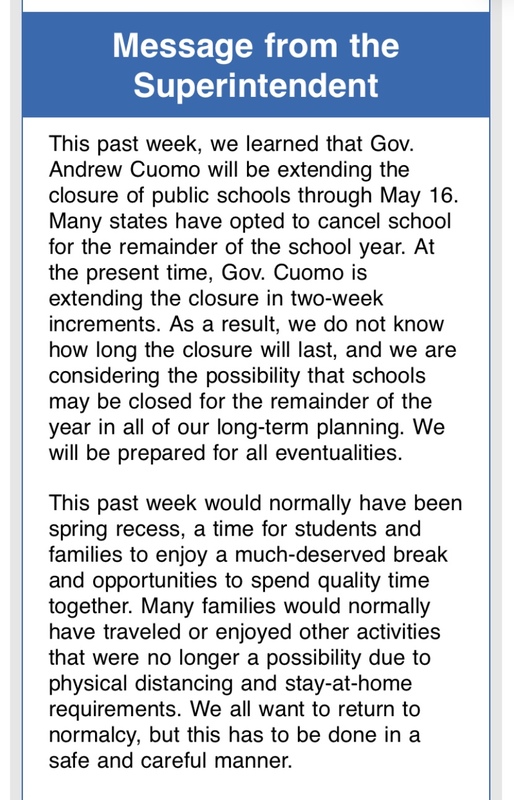
2020-03-20
Most people thought that we were getting an extra two weeks off of school and that this covid "thing" would blow over. Everyone thought this was short term and nobody expected to not be in schools for a year and a half and have their lives rearranged.
-
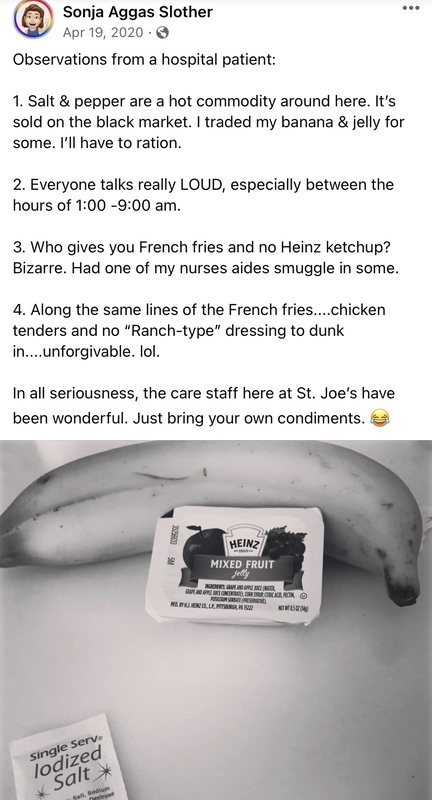
2020-04-19
This is a post that my Mom shared on Facebook while she was in St. Joseph's in Cheektowaga for Covid 19 care. My mom discusses her observations as a Covid patient in a Covid hospital in April of 2020.
-
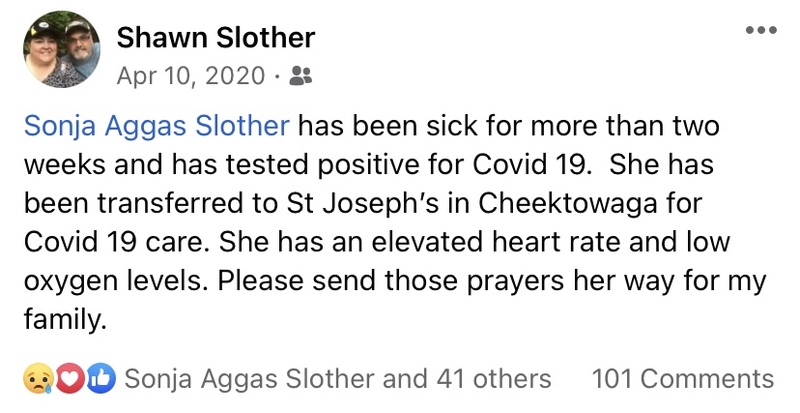
2020-04-10
My mom had been sick for more than 2 weeks at my house at the end of March-early April. One morning she woke up and could barely catch her breath or breathe. My dad took both her and my brother who has similar symptoms to the emergency room. They transferred my mom to St. Joseph's for low oxygen levels and an elevated heart rate. My brother was sent home as his symptoms and current levels weren't enough to get him admitted due to the over crowding in the hospitals at this time.
-
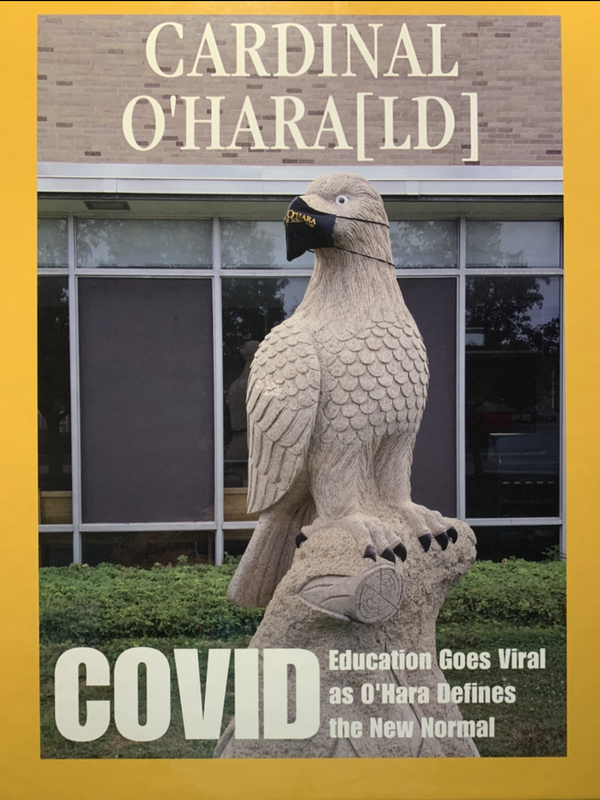
2021-05-21
Being one of two editors for a school-wide yearbook is challenging enough, but when COVID hit, it changed the way that we were able to record our schools history. Events were cancelled, and those that weren’t imposed limited attendance policies, which made it more difficult to take photographs and conduct interviews. To aid with this, we sent out requests to the student body, asking them to submit photos for the yearbook. This relieved some of the pressure, as we now had access to more content, but it still posed challenges. Even with the photos that we were able to obtain, the subjects of the photos were always wearing masks, making it more difficult to identify who was present. Despite these numerous struggles, we were able to complete the yearbook and publish it for the student body to enjoy. To capture the year as a whole, we chose to theme the book after the most prominent event of the school year; COVID.
Each page in the book was designed to reflect COVID in one way or another. Although this implied a more serious tone to this book, my co-editor and I strived to add humor where and when we could. Of these, my favorite was a poem that I wrote, titled “ ‘Twas the Night Before COVID-MAS”, a parody of “ ‘Twas the Night Before Christmas”. While some lines of the famous poem remained the same, I added my own touches to most of them, to better reflect these troubling times. With this story that I have now shared to the world, I have also included an audio reading of this poem. I hope it brings you a few laughs.
-
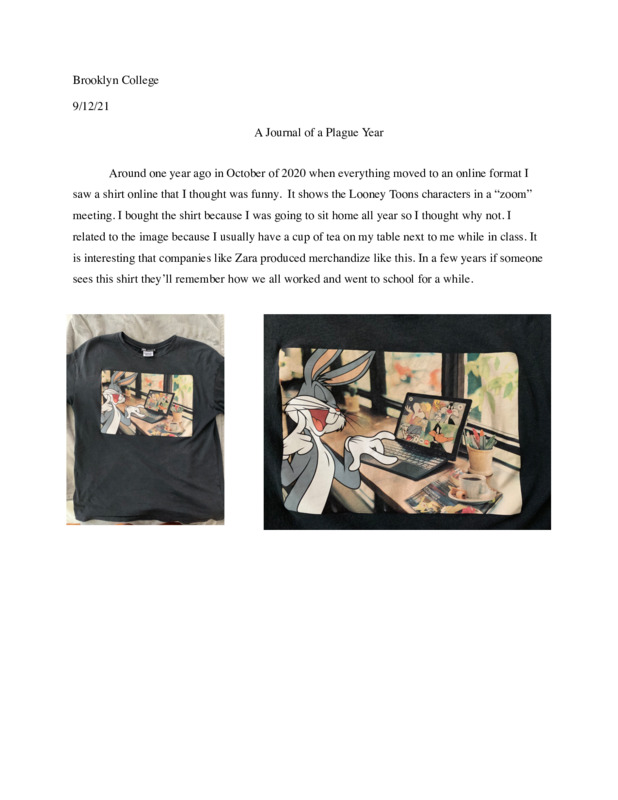
2020-10
The object I am uploading shows us how fashion is also impacted by Covid, it is really interesting.
-
2021-09-10
My husband and I bought a little secluded farm in Vanleer, Tennessee in 2013. We had this idyllic notion that we could grow our own food, live off the grid, and have a sense of privacy we never had living in the city. But, were were awful at it, nothing ever grew, our house was the ultimate "fixer-upper" and we were far from everything. In the last two years or so, we started to long for living in the city again, being near conveniences, and not commuting over one miles a day.
Then, the pandemic came and my job sent us all home to work remotely. I am museum curator and what I do is very hands on, so that took some clever adjustment and reinvention. We also have the world's slowest internet, but I made it work by duct taping the jetpack to the only window where it worked. As the months went by, I read so many accounts of how the isolation and seclusion of shelter in place orders led to depression. Some of my friends who lived in apartments in the city described feeling claustrophobic and trapped. I realized, that despite other uncertainties caused by the pandemic, that I was happier than usual and felt completely peaceful in our little secluded twelve acre homestead. I could roam around my own land, take my dogs for walks, work on the never ending house projects, or just sit on the porch and appreciate the sunset.
When things started to return to normal and we began going back into the office, I broke my foot while trail running and that added another seven months of completely remote work to my job. Physically, my recovery was grueling, but mentally I was doing well thanks to the time already spent quarantining during the pandemic.
I have a new love and appreciation for this little farm that won't grow anything now. Both my husband and I have no desire to move back to the city and we have even made peace with the fact that we will never finish all the fixer-upper chores. The gratitude I feel for this beautiful place is immeasurable. I am one of the lucky people who could quarantine and not feel like I was suffering. During the pandemic, we built a small A-frame cabin down near the front of our land and offered it up as a refuge for people who needed to leave the city for a day or two. Now, it's my little yoga cabin and a place where I can sit and be thankful for my little home in the forest.
-
2020
When the pandemic started, I was told that we were staying home for two weeks. My first thought was “Sweet. An extended spring break.” I thought I would have to come back to school after those few days and continue on with my life as it always has been. I was wrong. Days turned into weeks and weeks turned into months and before I knew it, I had lost an entire year of my life. I had no human contact outside of my family that entire time. I was kept in my room all day, everyday. After a while of online school and nothing else going on, I think that's when something had snapped inside of me. I experienced self reflection. With all of that time and no one but me, I just looked at myself, looked back into everything I have done and pondered on what I wanted to do with myself. I was already aware of how insignificant I was and how little I have done in life but I did not really understand just how little until I had that time to myself. I already had a list of things I wanted to change about myself and things I wanted to do so I think that is when I began working to be better. I spent a lot of time alone practicing how to act more patient and be friendlier. I practiced baking, I took care of babies a lot, I appreciated the little things I always have since I was young like a video game I play called Minecraft, I began documenting and recording everything I did, I studied foreign language, etc. Soon I started to make changes to myself. When I got mad, I would think of my nephew or I would imagine I am watching the kids and remember that I have to be patient with them. I practiced self love so when I got major depression episodes or anxiety attacks, I was able to comfort myself easier and walk myself through my struggles. I also cut back on the food I ate and the types of food I ate. I lost about 10 pounds in one week and I was super proud of myself especially since I was working out like every day. I was in really good shape and proud of myself for that. I had better stamina and my clothes fit better and I was getting a lot of foreign language practice in and I finished learning how to read and write korean as well as some simple vocabulary and sentence structure. I improved on writing since I wrote a lot more and helped develop my techniques and practiced some drawing. I spent a lot of that time sitting alone in my room and adjusting to that silence. I've improved as a listener and began to crave silence all the time. My life has not been peaceful in the least bit but I have been able to find peace within myself which has really helped in the long run so far. Having improved on myself and re-exploring hobbies and interests of mine, I was reintroduced to the loud and crowded public abruptly to which I responded with an anxiety attack but then I got more comfortable. I was super shy at first but now I feel generally happier all the time and I believe that has helped people around me relax and enjoy my presence more. I am glad I seem less threatening or mean because that is all I have been called my entire life. I am still weird and awkward and I am not anyone’s first option but I am glad I am not the last option now. My goal now is to enlist as soon as I can and go into community college. Once highschool ends for me then I will begin my life and I am super stoked about that. I have a few ideas of what I can do after highschool so I am just waiting it out now. At least this much good came out of quarantine.
-
2020-03-20
At the start of the pandemic, I was facing home insecurity and was living in a shelter for three months and special housing for 6 months. The city was the most empty I have ever seen it. Ive seen so many people, homeless people, because of the pandemic and it was devastating. It isolated people.
-

2020
Brooklyn College HNSC assignment prompt, taught by Margrethe Horlyck-Romanovsky
-
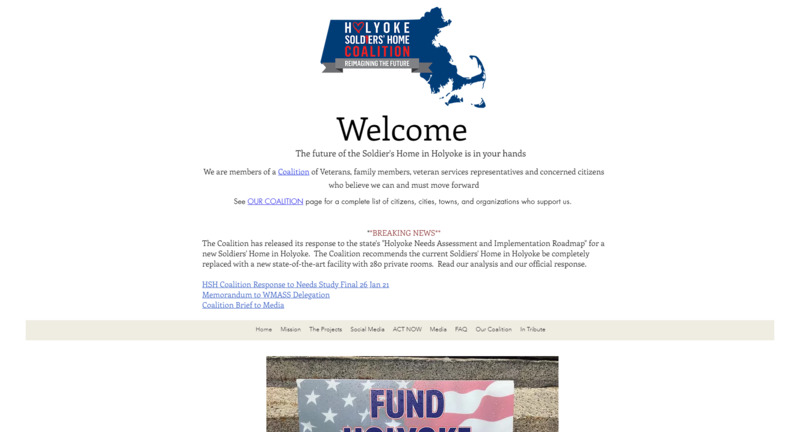
2020-11-11
The Holyoke Soldiers' Home coalition created this website in response to the COVID-19 outbreak at the Holyoke Soldiers' Home in Holyoke, Massachusetts. It provides updates on the efforts to build a new facility, the motivation for constructing a new and larger facility, the need for more staffing, and the possibility of new programs.
-
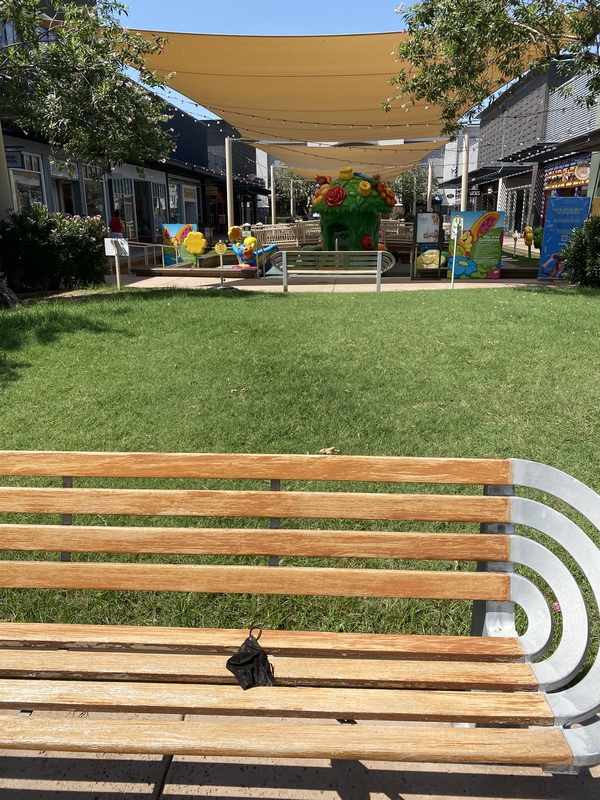
2021-09-07
Mask trash has become so common over a year into the pandemic. This one was found on a bench in SanTan Village mall in Gilbert, Arizona.
-
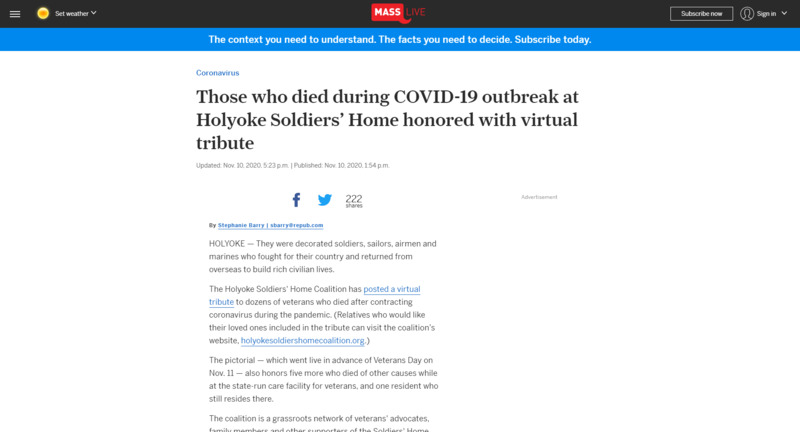
2020-11-10
This MassLive article reports on a coalition attempting to memorialize the veterans at the Holyoke Soldiers' Home in Holyoke, Massachusetts, who had died throughout the pandemic, most of them as a result of contracting COVID-19.
-
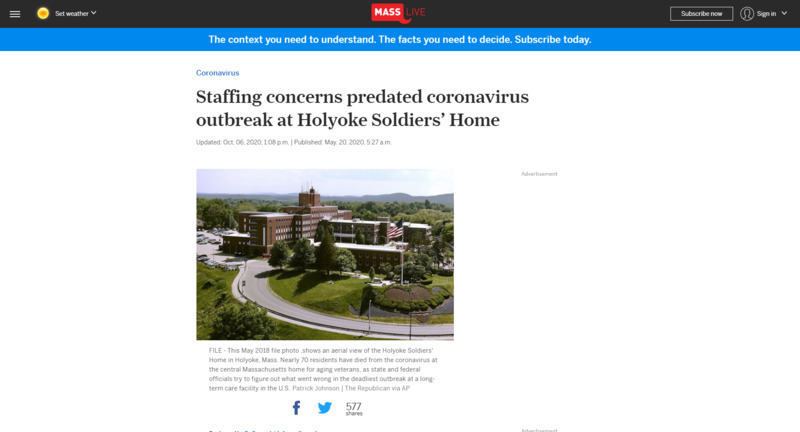
2020-10-06
This MassLive article reports on a pre-existing staffing shortage at the Holyoke Soldiers' Home in Holyoke, Massachusetts, that influenced the gravity of the COVID-19 outbreak in the facility.
-
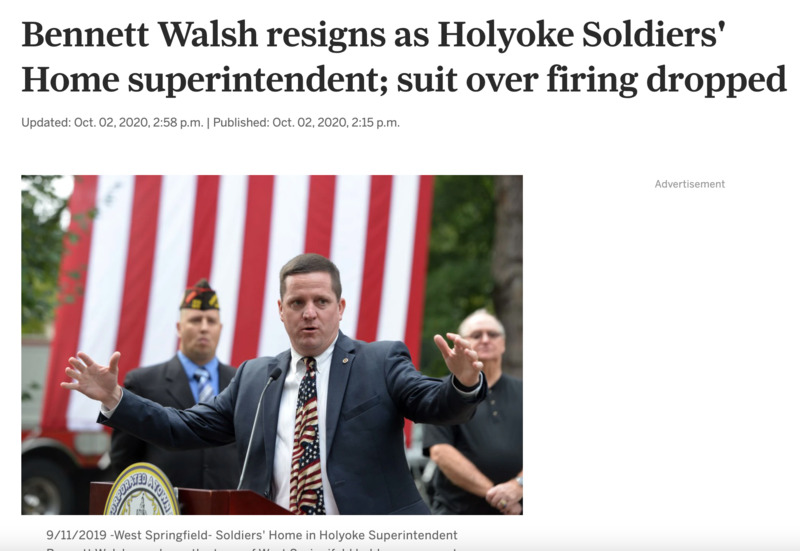
2020-10-20
This MassLive article reports on Holyoke Soldiers' Home superintendent Bennett Walsh's decision to drop a law suit after Massachusetts Governor Charlie Baker had him fired in light of the facility's poor response to the pandemic.
-
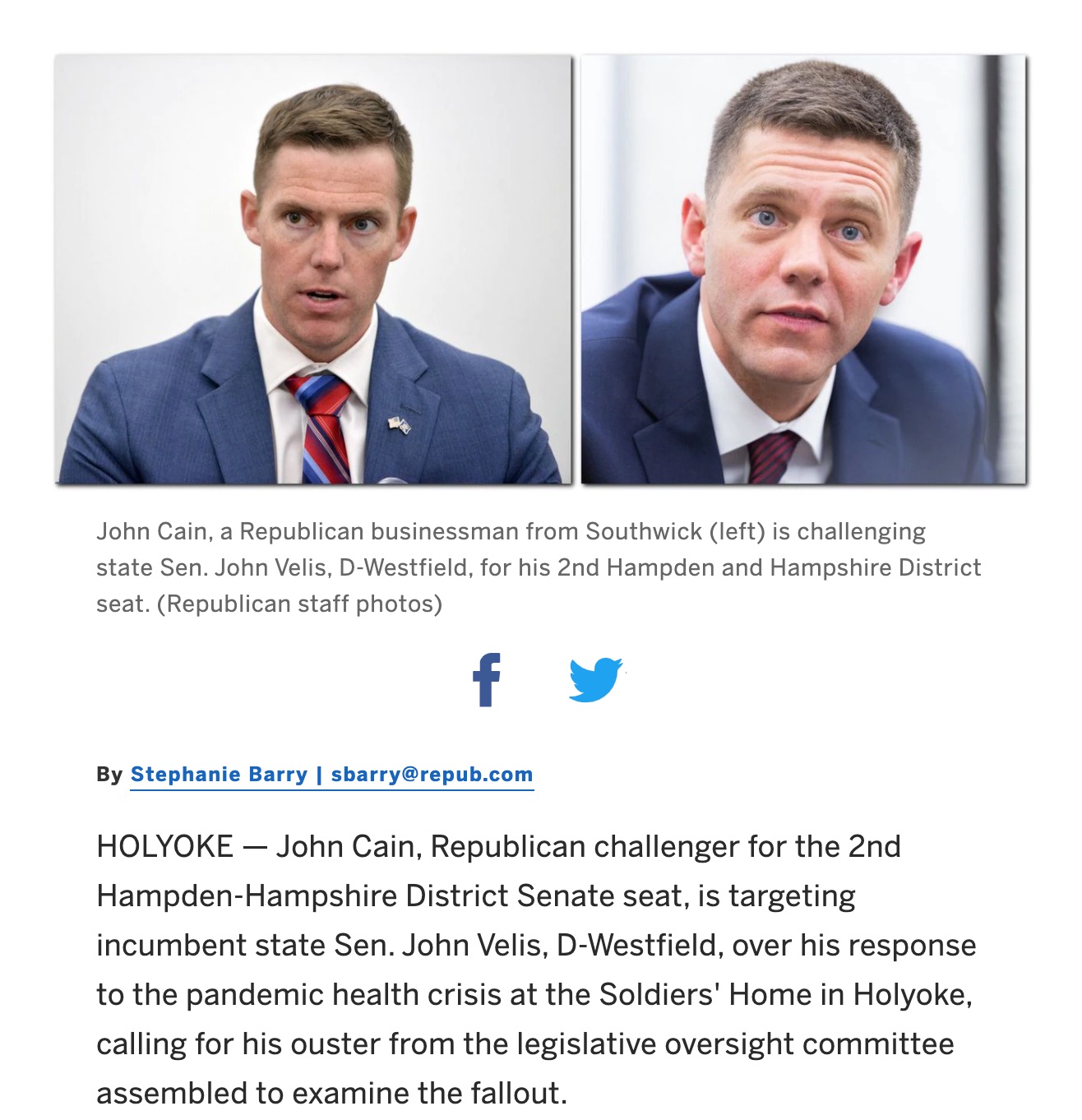
2020-09-13
This MassLive news article discusses how a state senate candidate was using the poor response to the pandemic at the Holyoke Soldiers' Home during his opponent's term in office to gain popularity for himself.
-
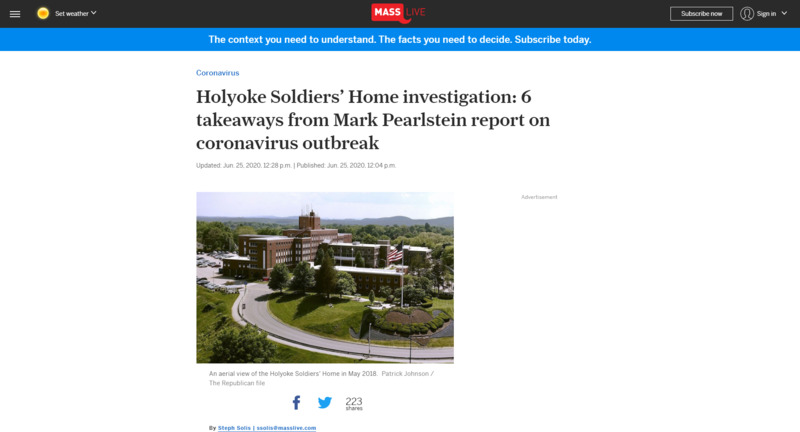
2020-06-25
This article comes from MassLive and reports on the major takeaways from a report that documents where the Holyoke Soldiers' Home in Holyoke, Massachusetts, failed in its COVID-19 response.
 2020
2020 2021-06
2021-06 2020-03
2020-03 2021-03-30
2021-03-30 2020-05
2020-05 2021-09-16
2021-09-16 2021-09-16T13:00:00
2021-09-16T13:00:00 2021-09-16
2021-09-16 2020-06
2020-06 2020-05
2020-05 2020-10
2020-10 2020-08-15
2020-08-15 2021
2021 2020-03-01
2020-03-01 2020-03-01
2020-03-01 2020-03-15
2020-03-15 2021-09-15
2021-09-15 2021-01-19
2021-01-19 2021-02-01
2021-02-01 2020-04-16
2020-04-16 2021-09
2021-09 2021-09-15
2021-09-15 2021-03-12
2021-03-12 2021-09-14
2021-09-14 2021-09-14
2021-09-14 2021
2021 2021-09-16
2021-09-16 2020-04-24
2020-04-24 2021-09-13
2021-09-13 2021-09-12
2021-09-12 2021-09-09
2021-09-09 2020-10-08
2020-10-08 2020-09-16
2020-09-16 2020-03-11
2020-03-11 2020-03-20
2020-03-20 2020-04-19
2020-04-19 2020-04-10
2020-04-10 2021-05-21
2021-05-21 2020-10
2020-10 2020
2020 2020-11-11
2020-11-11 2021-09-07
2021-09-07 2020-11-10
2020-11-10 2020-10-06
2020-10-06 2020-10-20
2020-10-20 2020-09-13
2020-09-13 2020-06-25
2020-06-25